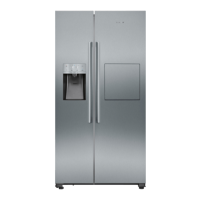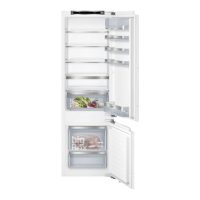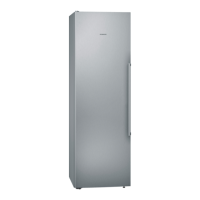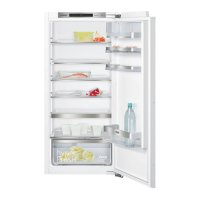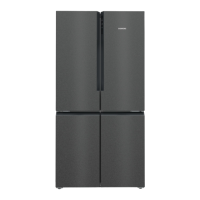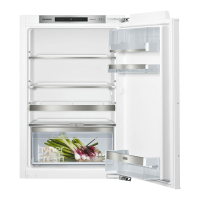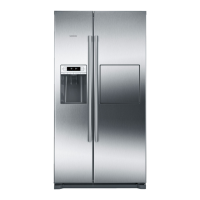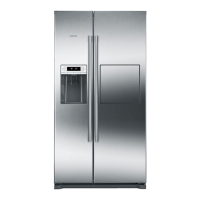
Do you have a question about the Siemens iQ500 KG56N Series and is the answer not in the manual?
| Energy Efficiency Class | A++ |
|---|---|
| Frost Free | Yes |
| Color | Stainless Steel |
| Climate Class | SN-T |
| Type | Freestanding Fridge Freezer |
| Total Capacity | 505 liters |
| Door Hinge | Right, reversible |
Read manual carefully, keep for reference, do not connect if damaged.
For chilling/freezing food and making ice cubes in private households up to 2000m.
May be used by children 8+ and impaired individuals if supervised.
Warning: High weight can cause injury. Do not lift alone.
Connect to properly installed earthed socket. Never use timers or remote controls.
Keep ventilation openings clear to prevent flammable gas mixture.
Do not use extension cables or non-approved adapters.
Only use in enclosed spaces. Avoid heat, humidity, steam cleaners.
Keep packaging material and small parts away from children.
Do not accelerate defrosting. Loosen stuck food with blunt object.
Do not operate electrical devices within the appliance.
Do not store carbonated drinks. Avoid damaging refrigerant tubes.
Do not touch hot parts. Avoid contact with frozen food and cold surfaces.
Prevent food contamination by cleaning surfaces and drain systems regularly.
Never operate a damaged appliance. Unplug immediately if damaged.
Keep flames away. Ventilate room. Switch off appliance if tubes are damaged.
Use sack truck or floor protection. Do not move in zigzag.
Do not stand or lean on appliance. Keep parts free of oil and grease.
Store only packaged food. Aluminium parts may corrode with acidic foods.
Never clean fittings and accessories in the dishwasher as they may deform.
Sort packaging materials by type for recycling.
Install away from heat sources, keep doors brief, do not block ventilation.
Check all parts after unpacking for transport damage and completeness.
Consider space volume, floor stability, and ambient temperature for proper installation.
Follow enclosed installation instructions for proper appliance fitting.
Remove protective materials and clean the appliance before initial use.
Connect the appliance's power cable to a nearby socket.
Diagram showing major parts of the fridge-freezer with numbered labels.
Explanation of the control panel for configuring functions and checking status.
Instructions for removing and re-inserting shelves for flexible storage.
Details on the storage container, its lower temperatures, and optimal use.
How to adjust humidity for storing fruit and vegetables longer.
Instructions for removing and re-inserting the door rack.
Information on using original accessories like egg trays and bottle holders.
Connect the appliance electrically to start operation.
Advice on temperature, door opening, and condensation to optimize performance.
How to turn off the appliance using the control panel.
Guide to adjusting refrigerator, storage, and freezer compartment temperatures.
Rapidly cools the refrigerator compartment. Switches off automatically.
Rapidly cools the freezer compartment for faster freezing. Switches off automatically.
Energy-saving mode for when the appliance is not in use for extended periods.
Sets appliance to save energy automatically.
Optimizes temperatures to keep food fresh longer.
Alerts if the appliance door is left open too long.
Warns if the freezer compartment becomes too warm.
Guidelines for storing various food types to maintain freshness.
Explanation of temperature variations and optimal storage locations within the compartment.
Information on how much food can be frozen within a specific time.
Tips for storing the maximum amount of frozen food efficiently.
Advice on packaging and placement for optimal frozen storage.
Instructions and tips for properly freezing fresh food items.
Recommended storage times for various foods at -18 °C.
The refrigerator compartment defrosts automatically.
The NoFrost system ensures the freezer remains frost-free; no defrosting needed.
Steps before cleaning: switch off, disconnect, remove food and fittings.
Use mild detergent and water. Dry thoroughly with a soft cloth.
Instructions for safely removing shelves, door racks, and storage containers.
Identifies issues like cooling failure, lighting problems, warm panels, and alarms.
Guidance on what to do during and after a power failure.
How to run a self-test to diagnose faults and communicate with customer service.
Steps for safely decommissioning the appliance.
Environmentally friendly disposal methods and safety warnings.
Information on warranty, product numbers, and contact details.
Details on refrigerant, capacity, and other technical specifications found on the rating plate.




